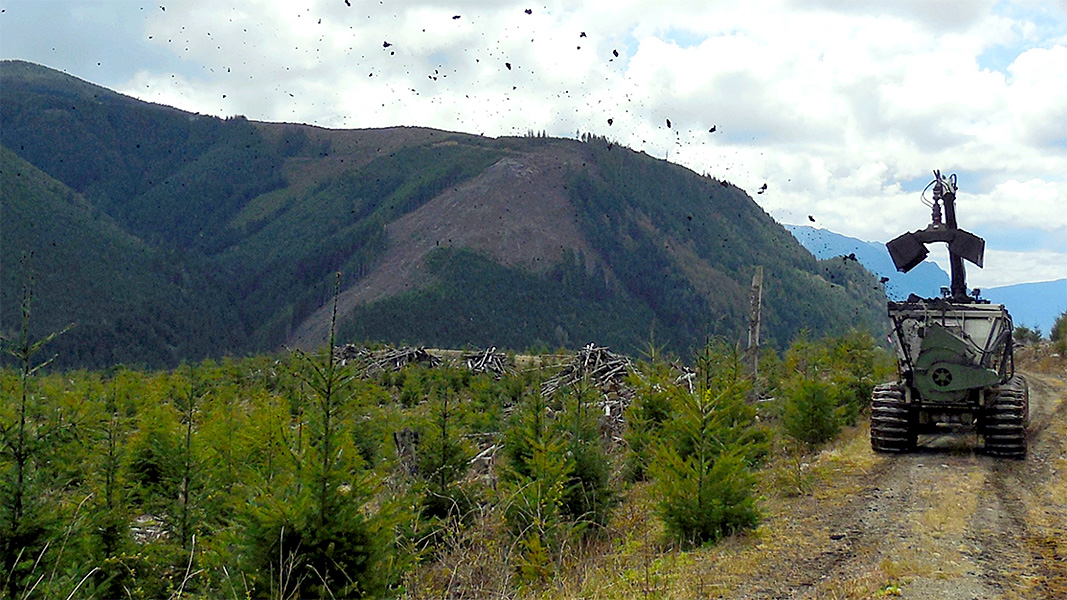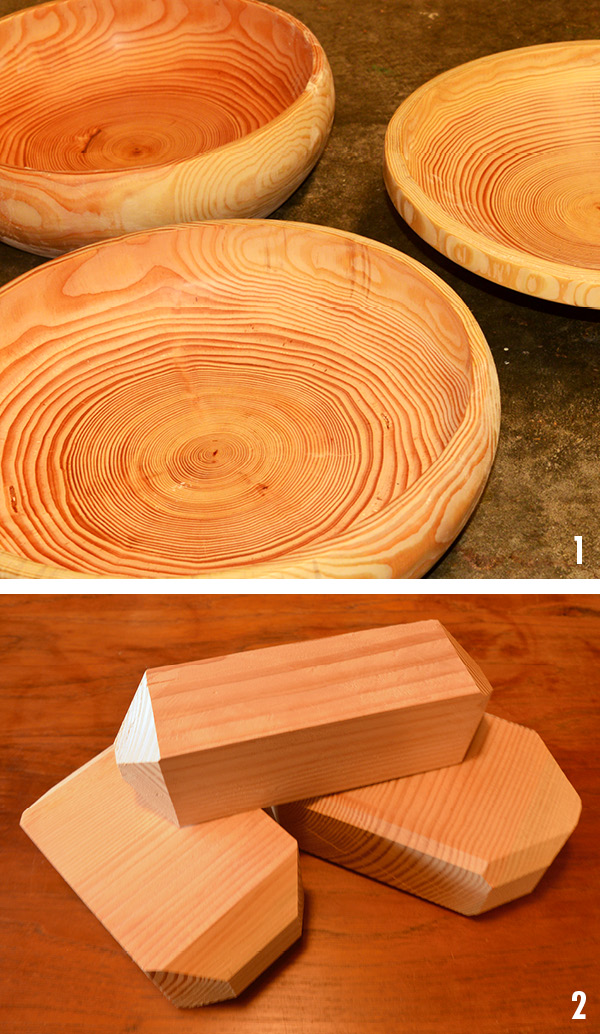Top: Current application technique of dewatered biosolids to Douglas fir. Photos courtesy of Chuck Henry
Chuck Henry and Dale Cole
Fifty years ago, faculty at the University of Washington (UW) College of Forest Resources (CFR) launched a research program applying dewatered biosolids (then, definitely sewage sludge) from the (then called) Municipality of Metropolitan Seattle (METRO) to forest land. The enactment of the federal Clean Water Act in the early 1970s caused this dramatic change in residuals management from discharging into the Puget Sound from an outfall at METRO’s main sewage plant. Having to discontinue this disposal method, METRO had a legal responsibility to explore alternative avenues for management of its biosolids.
Seeing the dilemma METRO was facing, coauthor Dale Cole, a professor at CFR, proposed a study exploring the feasibility of application to forest land — using the UW CFR’s Charles Lathrop Pack Research Forest — as a study site. The purpose was to determine the viability of applying this material to forest land to improve forest growth and establish whether there would be any detrimental environmental consequences. It had been well established by former CFR professor Stanley Gessel that the vast majority of Douglas fir in western Washington responded to a nitrogenous fertilization. Thus, a response to biosolids was also anticipated.
Pack Forest was not the first site where municipal sewage sludge was applied to forested land. Prof. Bill Sopper, Penn State, utilized this material to alleviate the degraded soil conditions where coal mine spoils had been deposited on former forest soils in the Appalachian region. His studies clearly demonstrated the utility of this waste product for reclaiming the productivity of these sites for growing trees.
Similarly, the CFR program at Pack Forest initially focused on treating recently harvested forested land with biosolids, yet it was always our intention to develop a means of applying this material to an established forest. The first such attempt in 1973 was on a 25-year-old stand of Douglas fir at Hugo Peak, a very low fertility site. We had two questions in mind when the first applications were made: Was it feasible to spread the semi-solid biosolids into a forest area? What might be the growth response?
Initial Application
There was nothing precise in this initial effort to apply biosolids into an existing forest. The site was first thinned in that the existing stand of 25-year-old Douglas fir was thick with smaller trees and access had to be improved. The biosolids was end-dumped from a truck so it would flow down the gentle slope, aided by a small bulldozer to even out the applications. The amount applied was approximated to be 2-inches deep (47 dry tons/acre (ac), at about 20% solids), contributing about 2,800 lbs/ac of organic N and 800 lbs/ac of ammonium-N to the site.
Treated and control plots, approximately one acre in size, were established and measurements were done annually for 5 years (Figure 1), with the results reported in “Use of Dewatered Sludge as an Amendment for Forest Growth” (Henry and Cole 1983). It was noted in these early measurements that a dramatic growth response had taken place. Periodically, we’d cut down a tree just to satisfy our curiosity about continued growth response (Figure 2). Simply stated, it was amazing.
 This stand had been largely forgotten for the last 25+ years, while the overall program turned its focus on establishing plots where more reliable application and growth information could be derived, and other environmental related studies could be incorporated in the study designs. By 1983 the overall scope of the program had grown substantially and involved approximately 12 faculty from the University.
This stand had been largely forgotten for the last 25+ years, while the overall program turned its focus on establishing plots where more reliable application and growth information could be derived, and other environmental related studies could be incorporated in the study designs. By 1983 the overall scope of the program had grown substantially and involved approximately 12 faculty from the University.
Recent Analysis
In 2021, Professor Cole, now long retired, asked Bob Gonyea, the field manager of the original Hugo Peak installation, and some of the regional forest fertilization field crew to check out the original plot. Measurements were made, a tree was felled, and UW’s Dr. Kim Littke did the analysis. Growth response continues to be amazing after this single application! Table 1 summarizes the annual volume increase.
 In addition to growth measurements, we wanted to see about any residual effect on the soil. Coauthor Chuck Henry, former UW professor, sampled and had soils analyzed for total C and N. Table 2 presents the results from three holes in each the control and treated areas. In general, elevated average concentrations of both N and C were found — again, after a single application 50 years ago. Additionally (though not measured), one could expect that greater biomass at higher N concentrations adds to the total N pool in the treated compared to the thinned only stands.
In addition to growth measurements, we wanted to see about any residual effect on the soil. Coauthor Chuck Henry, former UW professor, sampled and had soils analyzed for total C and N. Table 2 presents the results from three holes in each the control and treated areas. In general, elevated average concentrations of both N and C were found — again, after a single application 50 years ago. Additionally (though not measured), one could expect that greater biomass at higher N concentrations adds to the total N pool in the treated compared to the thinned only stands.
 With the impressive long-term growth response and elevated N and C soils it could be suggested that the site was increased in its growth potential from what initially was Site Class V land (a Douglas fir that would grow less than 75 feet in 50 years) to a significantly higher Site Class (e.g., Site Class III: 115 feet in 50 years). Whether this increase in the growth capacity will carry over to the next generation can only be speculated on at this time. It is certainly our hope that this area at Hugo Peak be continued as a research demonstration area and the growth of the next generation of trees be closely followed to see if the application of biosolids can result in a growth response for the succeeding generation of trees.
With the impressive long-term growth response and elevated N and C soils it could be suggested that the site was increased in its growth potential from what initially was Site Class V land (a Douglas fir that would grow less than 75 feet in 50 years) to a significantly higher Site Class (e.g., Site Class III: 115 feet in 50 years). Whether this increase in the growth capacity will carry over to the next generation can only be speculated on at this time. It is certainly our hope that this area at Hugo Peak be continued as a research demonstration area and the growth of the next generation of trees be closely followed to see if the application of biosolids can result in a growth response for the succeeding generation of trees.

Application of rewatered biosolids developed in late 1970s (above). The current application method is illustrated in feature image found at top of this article.
Although the study at Hugo Peak was never intended to be a rigorous test of growth response (lack of replication, uncertainty on the amount and uniformness of the application), it did clearly demonstrate that the forest benefited from biosolids application with a dramatic long-term growth response, as well as elevated soil C and N levels remaining 50 years later. This growth information is being presented not because of the rigor of the research, but because of the dramatic nature of the response. Since our initial technique of applying the material by dozer was rudimentary at best, we developed a rewatered application by pumper truck, and later METRO (now the program is run by King County) developed a very effective method of applying dewatered biosolids into the forest in which the County continues to make applications to commercial forest lands.
The ground-breaking work at Pack Forest demonstrating biosolids application to an existing forest (with a significant growth response) opened up a major new landscape — the huge acreage of often poor productivity forest land. This alternative has led to programs in Canada, New Zealand, and Australia, as well as other programs in Washington State. Besides growth response and application technology, in its maturity the biosolids program at Pack Forest addressed a broad array of additional questions related to application to forest land including chemistry of the soil and ground water, fate of trace metals, survival of seedlings, impact on wildlife, survival and leaching of coliform bacteria, and economic analysis of applications.
Acknowledgements
This study was sponsored for the most part by grants provided by METRO and later by King County when it took over the sewage treatment responsibility. Funding continues with the longest running research grant at UW, now under the direction of UW Prof. Sally Brown. Over the 50 years other funding was received from U.S. EPA, Washington Department of Ecology, U.S. Forest Service, and other private companies. Over the several decades while this study was active many faculty, graduate students (resulting in 40 masters and eight doctorates from our program) and staff participated in the program and in the success it truly enjoyed.
Chuck Henry, PE, PhD and Dale Cole, PhD., were formerly professors at the University of Washington College of Forest Resources.














